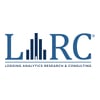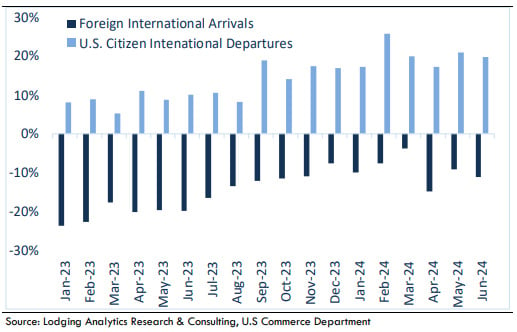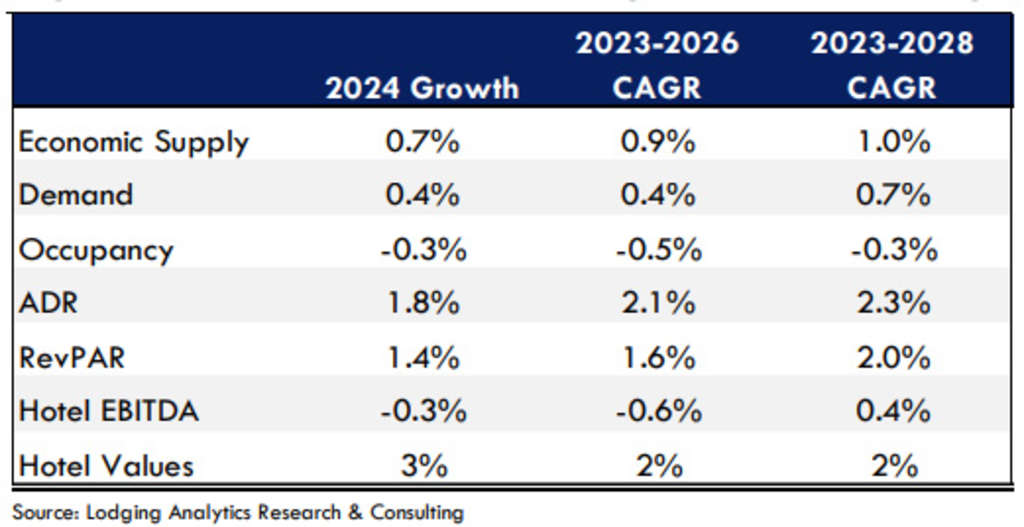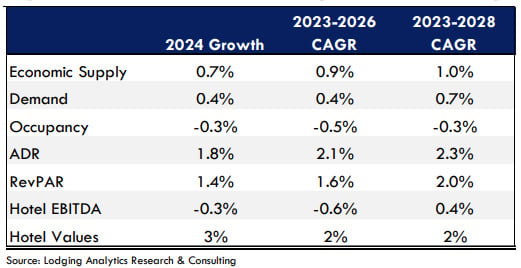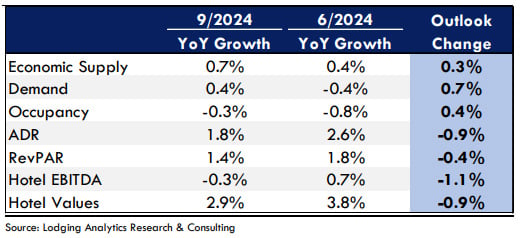Lodging Analytics Research & Consulting (LARC)’s 3Q-2024 Hotel Industry Outlook and Market Intelligence Reports
U.S. economic growth improved during 2Q-2024 with Real GDP having risen 2.8%, well above the 1.4% increase achieved in 1Q-2024. A strong U.S. economy fueled a national 2.5% RevPAR increase, an acceleration from the 0.0% RevPAR change during 1Q-2024. However, 2Q2024 performance was aided by an earlier than normal Easter observance as well as the rare total solar eclipse that occurred over a large swath of the nation in April.
While economic growth through the first half of the year was strong, cracks in the labor market began to emerge in July with non-farm job growth reported at 114,000 jobs, which was well below both consensus expectations of 185,000 jobs and June’s 179,000 job gain. Despite that concern, continued economic growth appears to be the general consensus. As of July, only 28% of economists surveyed by the Wall Street Journal expect a recession within the next twelve months (the lowest level since January 2022). However, signs of a softening consumer continue to mount, which is pressuring domestic leisure travel and limiting hotel industry growth as evidenced by the Visa Spending Index and Discretionary Spending Index, both of which have been declining. Additionally, although retail sales data have remained sluggish in recent months the July advance retail sales estimate was encouraging, pointing to a 1.0% month-over-month increase; the largest increase in quite some time. Meanwhile, headline inflation continues to moderate, with July’s reading of 2.9% the lowest level since April 2021. The combination of risks to the labor market and moderating inflation is driving economists to expect the Fed to cut interest rates at the September meeting, which is likely to stimulate economic growth, a positive for the lodging industry.
An uncertain U.S. presidential election may lead consumers and businesses to curtail spending in the second half of 2024. In fact, since 2000, presidential election years have seen Real GDP growth decline by 110 bps on average vs. the prior year. In each of the past four presidential election years, both demand growth and RevPAR growth slowed from the prior year. That risk may be further exaggerated by the pending expiration in early 2025 of the individual tax cuts passed under former President Trump and the expiration of Affordable Care Act health insurance subsidies expanded under President Biden. Additionally, the debt limit will need to be increased again in early 2025, which will further complicate these political qualms. Uncertainty surrounding all of these issues may weigh on hotel demand in the coming months.
The good news is that in the year immediately following each of the past two presidential elections, GDP, Business Investment and Hotel Demand growth have all accelerated from the election year prior.
In 2024, industry growth is being fueled by corporate transient, group, and inbound foreign travel while domestic leisure demand continues to wane. Group trends remain solid, helping generate a base level of demand that will further support pricing power. Nationally, we estimate that the convention center booking pace is up 4% on a year-over-year basis in 2024, following the 13% increase in 2023. The 2025 convention center booking pace is up 3% year-over-year and building momentum. Corporate transient demand trends are modestly positive, supported by growing corporate profits, stock prices and limited (very limited in some markets) improvements in office utilization.
Additionally, momentum in foreign inbound arrivals to the U.S. is encouraging, as the metric gradually narrowed throughout 2023 and by June 2024, year-to-date inbound visitation was just 11% below 2019 levels and up 11% year-over-year. The U.S. Dollar is forecast to weaken with declining interest rates, which should create a tailwind for inbound arrivals in 2025. As foreign travelers tend to stay longer and spend more than domestic travelers, the continued recovery of this portion of the leisure segment will have an outsized impact on hotel performance. In fact, according to the U.S. Travel Association, overseas visitors (which accounted for 47% of total international visitors in 2023) had an average length of stay in the U.S. of 18 nights, far exceeding the domestic traveler length of stay, estimated at around 2 nights.
International Travel Growth Rates vs. 2019 Levels
Unfortunately, an outsized portion of U.S. citizens are electing to travel abroad. In 2023, outbound international travel was 11% above 2019 levels. Importantly, that number only accelerated at the start of 2024. Through June, year-to-date U.S. citizen outbound international travel is up 10% year-over-year and 20% above 2019 levels. While that should create soft comparisons moving forward, momentum for outbound international travel remains strong however, growth may be stifled by a weakened U.S. Dollar in 2025.
It is important to note that not every gateway-oriented market will benefit from a foreign inbound travel recovery. Every market has experienced a different level of recovery of foreign travel and interpretation of these nuanced details will be critical to comprehending which markets will benefit from tailwinds related to inbound foreign travel and those that will not.
Moody’s Analytics economic forecasts incorporate the following key national assumptions that drive our outlook:
- The Fed has paused rate increases until cuts begin in September and drop 25 bps per quarter into 2027.
- U.S. GDP will increase 1.8% in the third quarter and 1.5% in the fourth quarter. U.S. GDP will increase 2.6% in 2024 and 1.7% in 2025.
With that backdrop, our current 2024 RevPAR outlook moderates to 1.4% year-over-year growth, fueled by a 1.8% increase in ADR and a 0.3% decrease in occupancy. For 2025, we forecast RevPAR to increase 2.5%, driven by a 3.1% increase in ADR and a 0.6% decrease in occupancy. The acceleration in RevPAR growth is driven by tailwinds (or at least fewer headwinds) as a result of the upcoming U.S. presidential election, improving group trends, fewer headwinds tied to domestic leisure demand and continued strength from inbound foreign arrivals.
However, should any of the above core macroeconomic assumptions meaningfully change, it could have a substantial impact on our U.S. lodging industry forecast.
We continue to expect there to be U.S. lodging markets that materially outperform as well as those that underperform national averages. Generally, we expect markets with outsized exposure to corporate transient, group, and inbound foreign travel recovery to be the near-term outperformers, while markets with the greatest exposure to domestic leisure demand and those underperforming from a group pace perspective to be the laggards in the near-term.
Furthermore, we anticipate financing costs to stabilize and transaction volumes to rebound. Expense pressures will become a substantial factor in identifying markets that are winners and those that are losers, especially with several major cities embarking on new collective bargaining negotiations. In Los Angeles, the hotel union reached an agreement with hotel owners/operators earlier this year that incorporates a wage increase of 40-50% over the next 4.5 years and a reset back to pre-pandemic staffing levels. Not only will this have an impact on the Los Angeles hotel market, but it is likely to be the barometer used across other collective bargaining agreements over the next couple of years. Those include Boston (agreement expired), Baltimore (agreement expired), San Francisco (agreement expired August 2024), San Jose (agreement expired August 2024), Seattle (agreement expired August 2024), New York (2026 renewal) and others. In fact, there are several labor strikes currently underway (Boston, Baltimore) or having been approved by membership (San Francisco, Seattle, Honolulu). We expect non-union hotels to keep pace with wage growth at union properties across these markets, though many are already paying wages above union-mandated levels.
As such, wage and expense growth and their strain on margin growth materially shapes our views on markets that are best and worst for investment today.
Transparency surrounding forecasting is critical to the lodging industry. We believe the best business decisions are based on the highest quality data and information available at the time of making such conclusion(s). We take that approach with our forecasts, using the best and most relevant available information to provide the most likely outcomes.
LARC’s industry-leading market intelligence is available to help all industry participants navigate the current environment and position themselves for success. Please contact us to learn more about our services and products, or if there is any other way we may be able to serve you.
LARC’s Industry Outlook
Currently, for 2024, Lodging Analytics Research & Consulting (LARC) expects U.S. RevPAR to increase by 1.4% to $99.56, driven by ADR growth of 1.8% to $158.65 while occupancy declines 0.3% to 62.8%. For 2025, LARC expects U.S. RevPAR to increase by 2.5% to $102.02, driven by ADR growth of 3.1% to $163.55 while occupancy declines 0.6% to 62.4%.
LARC forecasts 2024 U.S. Hotel EBITDA to decline 0.3%, with slight margin erosion, and Hotel Values to increase 3%. For 2025, LARC forecasts U.S. Hotel EBITDA to increase 1.2%, with slight margin erosion, and Hotel Values to increase 2%. Over the next five years, LARC expects Hotel Values to increase a total of 10%.
September 2024 U.S. Hotel Industry Forecast Summary
The below table illustrates a summary of LARC’s current U.S. Hotel Industry Outlook in contrast to last quarter’s outlook.
2024 U.S. Hotel Industry Forecast: September 2024 Edition vs. June 2024 Edition
Note that the vast majority of our outlook change was driven by softer 2Q-2024 results than expected. The remainder of the year is minimally changed, with RevPAR growth averaging about 1.5% for the second half of the year, which is consistent with the prior forecast. Ultimately, our 2024 view for supply and demand both improved, driving our occupancy forecast slightly higher. Our outlook for ADR slightly declined, which combined with our improved occupancy growth outlook, drives a 0.4% decrease to our 2024 RevPAR outlook. The top-line negative revision translates to a reduction in our Hotel EBTDA outlook, which in turn reduces our outlook for Hotel Values.
LARC’s U.S. RevPAR model has an R-squared of 98.7% with a standard error of 2.7%, back-tested to 2000. LARC’s U.S. Cap Rate model has an R-squared of 98.5% with a standard error of 26 bps, back-tested to 2005.
Market Outlooks
Listed below are the best and worst performing markets based on our forecasts. Similar to LARC’s U.S. forecast, our market level forecasts are structured on multi-variable regression models with a high level of historical accuracy.
Additional detail regarding our market outlooks can be found in LARC’s Market Intelligence Reports. Please contact us if you are interested in purchasing any of LARC’s offerings.
2024
Top Markets for RevPAR Growth:
Houston, Minneapolis, San Jose, Indianapolis & Seattle
Bottom Markets for RevPAR Growth:
Maui, Nashville, Phoenix, Anaheim & Los Angeles
2025
Top Markets for RevPAR Growth:
Maui, San Jose, Honolulu, Philadelphia & New Orleans
Bottom Markets for RevPAR Growth:
Kauai, Indianapolis, Omaha, Kansas City & Austin
5-Year Outlook (2023- 2028)
Top Markets for RevPAR Growth:
Maui, Raleigh, Honolulu, Orlando & Sedona
Bottom Markets for RevPAR Growth:
Cincinnati, Austin, Savannah, Kansas City & Portland (ME)
Top Markets for Value Change:
Las Vegas, Puerto Rico, Seattle, Orlando & New Orleans
Bottom Markets for Value Change:
Chicago, Boston, St. Louis, San Diego & Austin
Ryan Meliker
President
Lodging Analytics Research & Consulting, Inc
